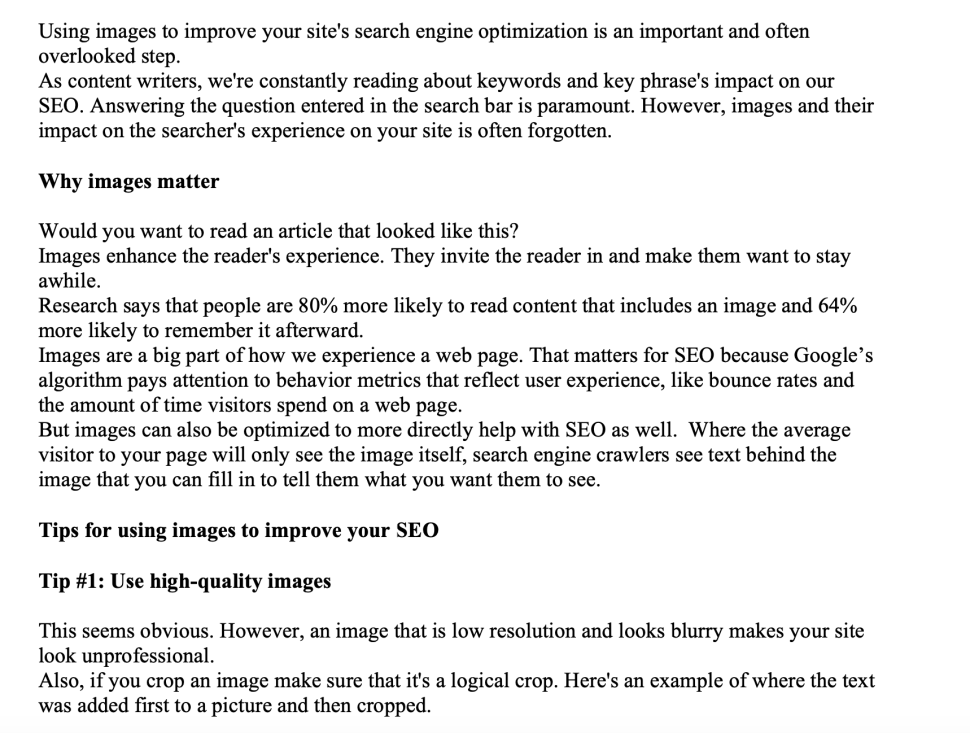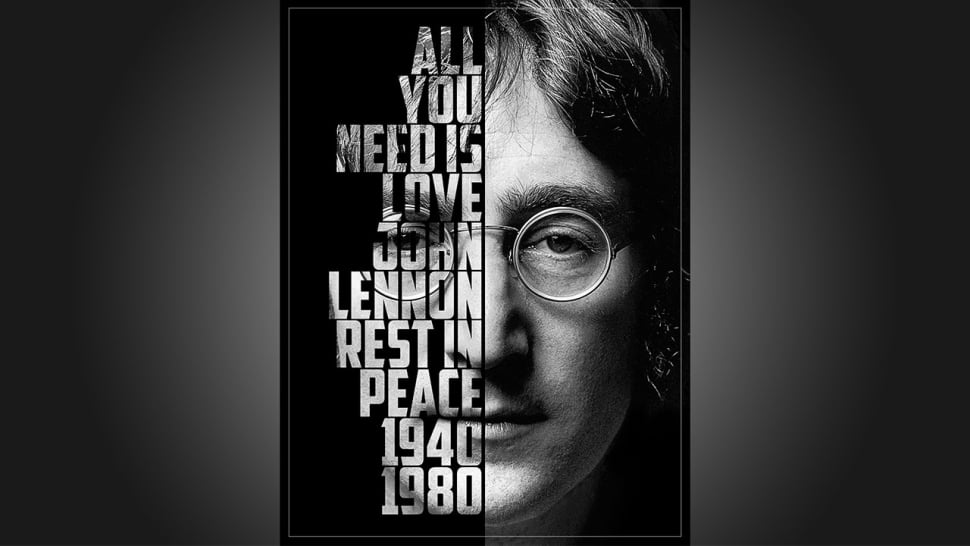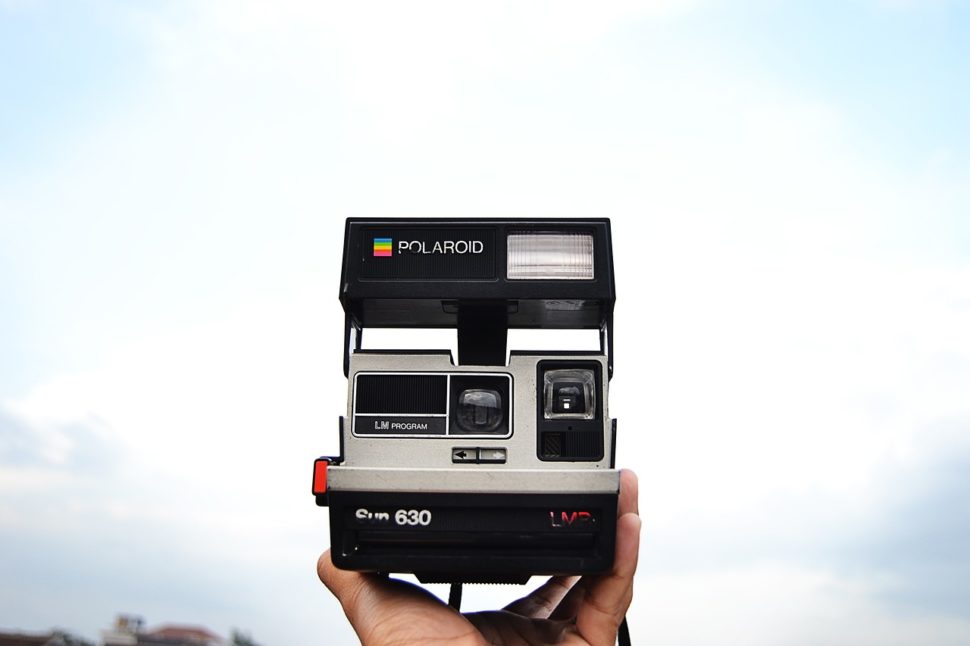Today, we’re going to discuss tips for using images to improve your site’s SEO. Images and graphics are an important and often overlooked step in search engine optimization.
As content writers, we’re constantly reading about how key phrases impact on our SEO. Answering the question entered in the search bar is paramount. However, images and their impact on the searcher’s experience on your site is often forgotten.
Let’s talk about what image SEO is. It’s the optimization of images, videos, graphics, etc. so they rank on Google and other search engines. This is another opportunity for you to capture the attention of your target audience. Let’s don’t waste it.
Why Images Matter


Would you want to read an article that looked like this?
Images enhance the reader’s experience. They invite the reader in and hopefully make them want to stay awhile.
Research says that people are 80% more likely to read content that includes an image and 64% more likely to remember it afterward.
Images are a big part of how we experience a web page. That matters for SEO because Google’s algorithm pays attention to the reader’s behavior. Google looks positively on pages where readers tend to stay for a while.
But images can also be optimized to more directly help with SEO as well. Most visitors to your site will only see the image itself. However, search engine crawlers see the text behind the image. You can control exactly what they see.
Tips for Using Images to Improve Your SEO
This seems obvious. However, an image that is low resolution and looks blurry makes your site look unprofessional.
Also, if you crop an image make sure that it’s a logical crop. Here’s an example of where the text was added first to a picture and then cropped.


The image is also blurry and doesn’t appear to be high-quality.
Above is a great example of what not to do.
Here is an example of what an image with text should look like.


Yes, these are extreme examples. However, they illustrate the point of how important image quality is.
Tip #2: Use Relevant Images in Your Content
An image should enhance the reader’s experience. It should assist in explaining your keywords or key phrase.
It’s critical that an image be relevant to your content so it can improve your SEO.


This picture above is lovely and eye-catching. However, it has nothing to do with this article. A reader would be confused about why it was added. Did they miss something?
Images must be on-topic and answer keywords. If not, then you just leave your reader scratching their heads.
Tip #3. Name Your Images to Improve Your SEO.
Most visitors will never see the filename. However, naming the image something relevant to your article will tell Google a bit more about what your page is about.
Try to work in keywords, but don’t keyword stuff.
For example, your site sells hair products. You are writing an article about oil-reducing shampoos. Don’t name an image “Shampoo2.” Think of something that will enhance your SEO by telling Google more about your article. Instead, name the image “Best oil reducing shampoo.”
The image name reinforces your keywords. Such a simple step!
Tip #4 Your Image ALT Text Matters
Know your target audience. Before you begin writing your content, you should define the keywords or a key phrase that you’re aiming to rank number one with.
Try to find images that compliment the keywords that you’ve identified. These act as another opportunity to boost your SEO.
However, this is not the time to stuff keywords into your text. You are describing the image for someone who can’t see it. That should be your main focus.


For example, Home Slice Pizza wants to increase its online presence. They post this picture of their restaurant.
Here’s what not to do…
alt=”Pizza is our specialty at Home Slice Pizza. We offer friendly service and outdoor dining. “
Close your eyes. If someone read you the above description would this be what you picture? No. The image ALT Text sounds more like a meta description of the site than it describes the picture.
They stuffed keywords like “pizza,” “outdoor dining,” and “friendly service” into the image ALT text. Those keywords are important to mention in your content, but they do not explain to the reader what’s happening in the picture.
How it’s fixed
alt=”Home Slice Pizza’s Christmas lights light up outdoor dining. Sign says Queen of Pies.”
This is why this image ALT text works. Close your eyes again. If someone read you this description I bet you would imagine something close to what is happening in the image. The ALT text also mentions the name of the business and the keyword of “outdoor dining.”
Most importantly, this ALT text tells Google what your image is really about.
Tip #5: Image Captions Matter
Image captions like image ALT text are viewable by Google. It’s another opportunity to let web crawlers know what your site is about.
Try to work in keywords or your key phrase in a natural way that explains the picture. Images with misleading captions are frustrating to readers.
It’s also another way to enhance your answer to the searcher’s question.
Leaving captions blank is a missed opportunity in terms of SEO and user experience.
Tip #6: Use High-Quality Images
You want your images to look high-quality. However, they can’t be too large, or they will slow down your site’s loading time. Searchers do not want to wait while your page loads. And they won’t. They’ll click on another link which hurts your ranking.
Lately, I’ve been working with INK’s built-in image optimization feature. You choose what image you want to load into your content and INK does the rest.


INK also has an image ALT text feature that assists in optimizing this important factor in your image SEO.
INK is free to use. Download it and see how great your images can look.
Tip #7: File Extensions Matter
There are three types of image files. Choose the one that works best for your site.
JPG: It’s one of the most common file types because it uses small file sizes and is widely supported. However, the quality is not always good and it doesn’t support a transparent background.
PNG: This file format is a higher resolution and can support a text description. The negative of PNG is that it tends to be a larger file size. It’s best for complex images and those that include text.
GIF: This file extension doesn’t support large variations of color. It’s great for simpler graphics. File size tends to be smaller and it does support a transparent background.


As with everything concerning search engine optimization, there is no one size fits all solution. Choose the file extension that works best for each individual image that you upload.
INK is the Content Writing and Image Optimization Tool That you Need to Improve your SEO.
As I mentioned above, INK has been the easiest way for me to stay on top of every part of my image optimization process.
Most importantly, INK costs nothing to use.
It is one of the best tools on the market for analyzing competing pages and optimizing your content for the highest SEO ranking.
You focus on writing with authority, and INK analyzes the competition, giving you real-time data. It determines the Flesch-Kincaid reading level and the number of words of your competition and compares it with your article.
To get a boost in your image optimization experience, you can download this valuable tool today.

